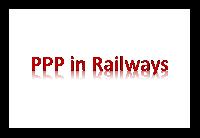
On PPP, Railway has been designing several initiatives from 2002 onwards. But private sector participation is not occurring substantially because of high degree of control over the entity by the government.
It is visible that across the globe, railways is not very successful in ensuring PPP investment because of the hgih government controll of the sector. In India, while inviting private money through PPP, railways have allowed investment mostly in building connectivity with ports and mines. Existing PPPs shows that the Model Concession Agreements for PPPs have balanced the interest of government and private sector in an equitable manner.
The Participative Policy of Investment in Railway Infrastructure
In the context of the relatively slow progress in attracting PPP, government brought a new approach in 2012 by classifying PPP investment groups and modes in a systematic manger. Similarly, the policy also introduced specific areas where each groups and modes are available. The policy is known as ‘Participative Policy of Investment in Railway Infrastructure launched in 2012’ to invite participation of investors. Both foreign and domestic and private and semi government and government entities can participate in the development of railway infrastructure.
As mentioned, uniqueness of the new policy is that it identifies entities of different nature including government, private and cooperative; that are interested in railway infrastructure development and financing. It gives selective importance to these entities based on a project to project basis. The policy was modified and more liberalized in 2014. A major feature of the PPP initiatives after the 2012 policy is that many projects are for building connectivity between railway stations and ports or last mile connectivity to commodity (like coal) production locations.
Besides laying the general provisions, the new policy gives specific projects on a case-to-case basis depending on the model of private investment. Ministry of Railways grant direct permission or go in for competitive bidding for award of a project.
PPP Participants
As per the 2012 Policy, following entities can participate in the development of railway infrastructure:
- State Governments
- Local bodies
- Beneficiary industries
- Ports
- Large import and export companies
- Co-operative Societies and other body corporate
- Infrastructure and Logistics providers
- PIO/Overseas Corporate Bodies
- Foreign Direct Investor (After FIPB clearance)
Private sector investment in PPP will be selective and the specific issues will be determined on a case by case basis.
PPP Models
The policy provides following five PPP models for implementation of various types of rail-connectivity and capacity augmentation projects:
- Non-Government Private Line Model
- Joint Venture (JV) model
- Build, Operate and Transfer (BOT) model
- Capacity augmentation with funding provided by customers
- Capacity augmentation through annuity model
As per the guidelines, three of these models (private line, JV and customer funded) involve participation of strategic investors/customers and two other (BOT and Annuity models) are pure PPP models.
Where PPP is allowed?
Through the above five models, Railways aims to mobilise substantial investments through various Projects/Schemes like Port Connectivity Projects, Private Freight Terminals (PFT), Private Container Operations, Liberalised Wagon Investment Scheme (LWIS), Wagon Leasing Scheme (WLS), Automobile Freight Train Operator Scheme (AFTO), Special Freight Train Operator Scheme (SFTO), Redevelopment of Stations and Locomotive Manufacturing Unit.
*********









